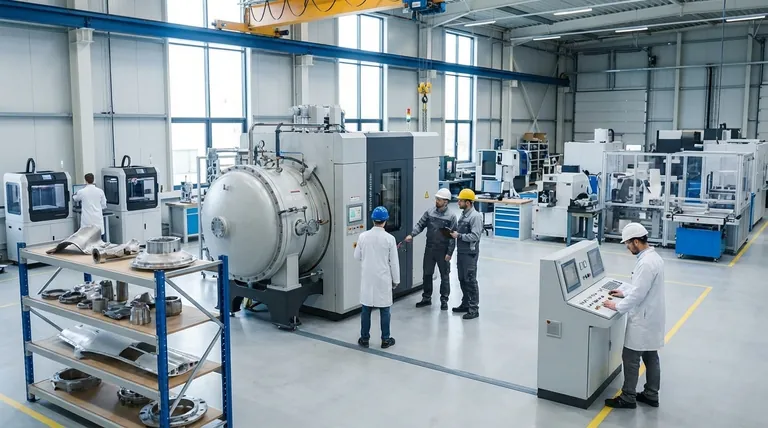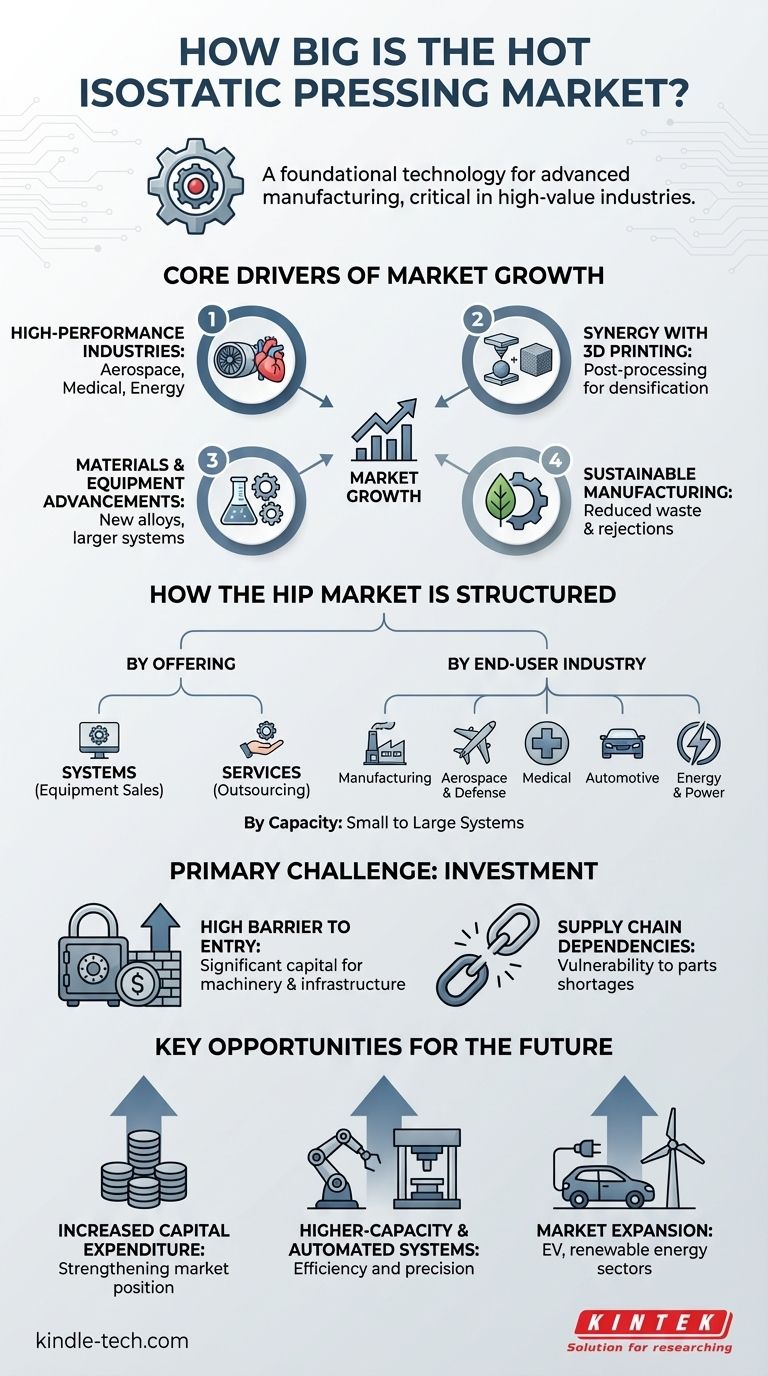While specific dollar valuations fluctuate, the size of the hot isostatic pressing (HIP) market is best understood by its critical and expanding role across high-value industries. The market's scale is defined by its application in aerospace, medical, and energy sectors, driven by a growing demand for components with superior mechanical properties and reliability.
The Hot Isostatic Pressing (HIP) market is not just a niche; it is a foundational technology for advanced manufacturing. Its growth is propelled by the relentless pursuit of material perfection in critical applications and its synergy with modern techniques like 3D printing.

The Core Drivers of Market Growth
The expansion of the HIP market is not accidental. It is a direct response to specific technological and economic pressures in modern industry.
Demand From High-Performance Industries
The primary driver is the non-negotiable need for high-performance components in sectors like aerospace, automotive, medical, and energy. These industries require parts that can withstand extreme conditions without failure, and HIP is a key process for achieving that level of material integrity.
Synergy with Additive Manufacturing
The rise of 3D printing has created a significant new demand for HIP. While 3D printing can create complex geometries, the resulting parts often have internal voids or porosity. HIP is used as a post-processing step to densify these parts, dramatically improving their mechanical strength and performance.
Advancements in Materials and Equipment
Continuous research and development in material science are unlocking new alloys and composites. Simultaneously, HIP equipment is evolving, with manufacturers introducing systems with higher capacity and more precise control, broadening the scope of what can be achieved.
A Push for Sustainable Manufacturing
HIP contributes to greener manufacturing practices. By eliminating porosity and defects in cast or printed parts, it reduces waste and material rejection rates, optimizing resource utilization and leading to more cost-efficient production cycles.
How the HIP Market is Structured
To fully grasp the market's dynamics, it's essential to understand its key segments. The market is not monolithic and is typically broken down by its offerings and the industries it serves.
By Offering: Systems vs. Services
The market consists of two primary offerings. Systems refer to the sale of the HIP equipment itself to manufacturers. The services segment, where companies outsource their HIP needs to specialized providers, is gaining significant traction as it lowers the barrier to entry for many users.
By Capacity: Small to Large Systems
HIP systems are categorized by their physical size and capacity, ranging from small-sized units for research and development to large-sized presses for industrial-scale production. Equipment can range from just a few inches to over 80 inches in diameter to accommodate different component sizes.
By End-User Industry
The market is also segmented by the industries that use the technology. Key end-users include manufacturing, aerospace and defense, medical, automotive, and energy & power. Each sector has unique requirements that drive specialized applications of HIP.
Understanding the Primary Challenge: Investment
While the benefits are clear, the HIP market has one major restraint that shapes its competitive landscape.
The High Barrier to Entry
The most significant challenge is the high initial investment required. Establishing a HIP facility involves substantial capital for advanced machinery, high-pressure vessels, specialized infrastructure, and rigorous safety protocols. This cost acts as a significant barrier for new companies looking to enter the market.
Supply Chain Dependencies
The ecosystem can also be vulnerable to disruption. A decline in production among component suppliers or system integrators can lead to shortages of essential parts for original equipment manufacturers (OEMs), impacting their ability to build and deliver new HIP systems.
Key Opportunities for the Future
Despite the challenges, several clear trends point toward significant future opportunities within the HIP market.
- If your primary focus is investment: The trend is toward increasing capital expenditure in HIP technology as established players and new ventures work to strengthen their market position and capabilities.
- If your primary focus is technology development: The greatest opportunity lies in creating higher-capacity systems and integrating advanced automation and control systems to improve efficiency and precision.
- If your primary focus is market expansion: Growing demand from the electric vehicle and renewable energy sectors, combined with strategic industry collaborations, presents a clear path to expanding business across new regions and applications.
Hot isostatic pressing is an enabling technology, fundamental to pushing the boundaries of what is possible in modern engineering and manufacturing.
Summary Table:
| Market Aspect | Key Insight |
|---|---|
| Primary Drivers | Demand from aerospace, medical & energy; synergy with 3D printing; sustainable manufacturing |
| Market Segments | Systems (equipment sales) & Services (outsourcing); categorized by capacity and end-user industry |
| Key Challenge | High initial investment cost for equipment and infrastructure |
| Future Opportunities | Growth in EV/renewable energy sectors; development of higher-capacity, automated systems |
Ready to leverage hot isostatic pressing technology in your lab? KINTEK specializes in providing advanced lab equipment and consumables to support your research and production needs in material science and advanced manufacturing. Whether you are in aerospace, medical devices, or additive manufacturing, our solutions can help you achieve superior material integrity and performance. Contact our experts today to discuss how we can support your specific application and drive your innovation forward.
Visual Guide

Related Products
- Warm Isostatic Press WIP Workstation 300Mpa for High Pressure Applications
- Warm Isostatic Press for Solid State Battery Research
- Manual High Temperature Heated Hydraulic Press Machine with Heated Plates for Lab
- 24T 30T 60T Heated Hydraulic Press Machine with Heated Plates for Laboratory Hot Press
- Automatic Heated Hydraulic Press Machine with Heated Plates for Laboratory Hot Press
People Also Ask
- What pressure is hot isostatic press? Achieve Full Density & Superior Material Performance
- How much energy does hot isostatic pressing consume? Unlock Net Energy Savings in Your Process
- What is HIP treatment for metal? Eliminate Internal Defects for Superior Part Performance
- What are some of the attractive properties of hot isostatic pressed products? Achieve Perfect Density and Superior Performance
- Is hot isostatic pressing a heat treatment? A Guide to Its Unique Thermomechanical Process



















